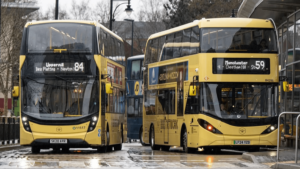My current daily routine demonstrates the increased importance of the local neighbourhood. Until 18 months ago, I would cycle into my office in central Cambridge every day; now my work as a Senior Planner can be done as much from the dining table of my flat as it can in the office.
The pandemic has led to us travelling, consuming, working and generally living differently.
And as both the residential and commercial property markets continue to illustrate, the 15-minute radius from our homes has never been more important.
It has brought to prominence the ’15-minute city’ concept, initially developed by Professor Carlos Moreno at the Paris-Sorbonne University as ‘a road map, an ambition, a new vision for cities’. Call it what you will – the 15-minute city, 20-minute neighbourhood, low traffic neighbourhoods, liveable neighbourhoods – all are based on the idea that more shops and services should be located close to where people live, with pedestrians, cycles and public transport prioritised.
The benefits are obvious: increased sustainability, more neighbourliness, decreased congestion, improved mental health, and better community resilience when disaster strikes (say, a global pandemic).
We should avoid definitional quagmires of what constitutes a ‘liveable’ mix of shops and services or what a 15-minute travel time looks like; it is more useful to think of the 15-minute neighbourhood as an organising principle, and as a lens through which development can be planned.
For local authorities, it can help determine where local services such as primary schools, doctors’ surgeries and libraries are located and how they interact with various modes of transport. For developers, it provides a focus when drawing up master plan.
Although developers and local authorities often already aim to develop in this way, the benefit of the concept is that these objectives can be more easily understood by the public.
And it’s not just a case of locating a school within a 20-minutes’ walk from home. That walk needs to be pleasant and easy – avoiding traffic fumes, complex road crossings and narrow pavements.
Whilst seemingly common-sense, it is vital to acknowledge the granular details and historic characteristics of each neighbourhood.
For cities and towns which have historically developed with pedestrians in mind, it should just be a case of looking again at issues of walkability and vehicular access and making improvements where necessary.
Then there’s villages and smaller towns. Not all have a full selection of services, but there is potential to link villages, to share services and promote walking and cycling between them. There is also the opportunity to deliver more in the way of mobile services, such as libraries and doctors’ surgeries.
Perhaps the greatest challenge is suburban developments. While today, new schemes are built on sustainable development principles, many estates from the 1950s-1990s were centred around the car. Where local centres do exist, they tend to be run down, requiring strategic thinking and investment from local authorities.
I have recently been involved in a project in East Barnwell in Cambridge which seeks to do exactly this. As a well-defined suburban neighbourhood approximately three miles from the city centre, it’s an ideal location for a 15-minute neighbourhood. But two large roads divide the neighbourhood into four and there are limited services. We were appointed by the City Council to review the public service assets, look at demographic profiles and determine which services should be introduced and re- or co-located to create more of a defined centre. It’s an interesting study and has real potential, but it’s also a long-term process, not something that can be fixed immediately.
The 15-minute neighbourhood isn’t a panacea and there are a few traps we must be wary of. Lower-income neighbourhoods already suffer from poorer services, fewer shops and an inhospitable public realm; when investing in improvements we can’t simply respond to those who shout the loudest. We should be mindful of how Neighbourhood Planning – potentially a great force for change – has been more successful in more affluent communities.
The impact on struggling town centres is another consideration. Many of us previously accessed services within 15 minutes of our offices; a continuation of working from home or a move towards suburban office hubs is great for local neighbourhoods but might pose challenges for high streets and city centres.
Furthermore, the introduction of Use Class E could dilute the role of high streets; if struggling shops are replaced by homes, it could actually reduce walkability by creating long stretches of dead frontages, undermining the agglomeration effects that make our centres attractive. There is a fine line to tread in increasing the vitality of town centres while retaining services.
Nor is it just a case of ‘build it and they will come’. In the absence of incentives, the ‘first mover’ will stay put and the 15-minute neighbourhood will remain nothing more than an ideal.

















Quality Used Engines & Transmissions For Sale In USA | FInd A Grade Certified Autoparts. High Performance & Low – Miles Guarantee. Choose your Part, Compare Price & Quality.